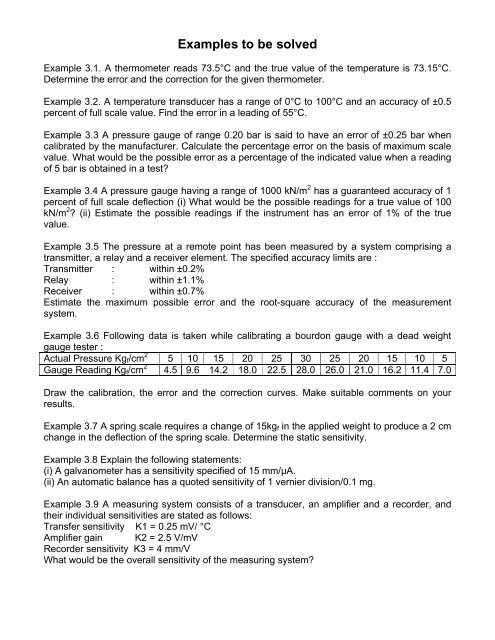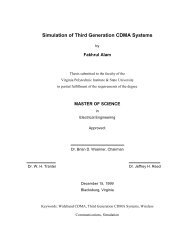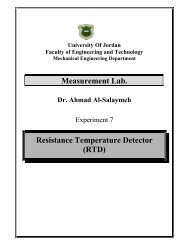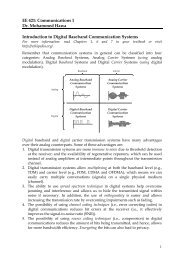Question Bank 2 - FET
Question Bank 2 - FET
Question Bank 2 - FET
Create successful ePaper yourself
Turn your PDF publications into a flip-book with our unique Google optimized e-Paper software.
Examples to be solvedExample 3.1. A thermometer reads 73.5°C and the true value of the temperature is 73.15°C.Determine the error and the correction for the given thermometer.Example 3.2. A temperature transducer has a range of 0°C to 100°C and an accuracy of ±0.5percent of full scale value. Find the error in a leading of 55°C.Example 3.3 A pressure gauge of range 0.20 bar is said to have an error of ±0.25 bar whencalibrated by the manufacturer. Calculate the percentage error on the basis of maximum scalevalue. What would be the possible error as a percentage of the indicated value when a readingof 5 bar is obtained in a test?Example 3.4 A pressure gauge having a range of 1000 kN/m 2 has a guaranteed accuracy of 1percent of full scale deflection (i) What would be the possible readings for a true value of 100kN/m 2 ? (ii) Estimate the possible readings if the instrument has an error of 1% of the truevalue.Example 3.5 The pressure at a remote point has been measured by a system comprising atransmitter, a relay and a receiver element. The specified accuracy limits are :Transmitter : within ±0.2%Relay : within ±1.1%Receiver : within ±0.7%Estimate the maximum possible error and the root-square accuracy of the measurementsystem.Example 3.6 Following data is taken while calibrating a bourdon gauge with a dead weightgauge tester :Actual Pressure Kg f /cm 2 5 10 15 20 25 30 25 20 15 10 5Gauge Reading Kg f /cm 2 4.5 9.6 14.2 18.0 22.5 28.0 26.0 21.0 16.2 11.4 7.0Draw the calibration, the error and the correction curves. Make suitable comments on yourresults.Example 3.7 A spring scale requires a change of 15kg f in the applied weight to produce a 2 cmchange in the deflection of the spring scale. Determine the static sensitivity.Example 3.8 Explain the following statements:(i) A galvanometer has a sensitivity specified of 15 mm/μA.(ii) An automatic balance has a quoted sensitivity of 1 vernier division/0.1 mg.Example 3.9 A measuring system consists of a transducer, an amplifier and a recorder, andtheir individual sensitivities are stated as follows:Transfer sensitivity K1 = 0.25 mV/ °CAmplifier gain K2 = 2.5 V/mVRecorder sensitivity K3 = 4 mm/VWhat would be the overall sensitivity of the measuring system?
Example 3.10 A pressure measuring system consists of a piezoelectric transducer, a chargeamplifier and a ultra violet charge recorder. The sensitivities of these elements are stated asfollows:Piezoelectric transducer, K1 = 8.5 pC/barCharge amplifier, K2 = 0.004 V/pCUltraviolet charge recorder, K3 = 20 mm/VWhat would be the deflection on the chart due to a pressure change of 30 bar?Example 3.11 How resolution is reckoned for the analogue and digital read out devices?Example 3.12 A force transducer measures a range of 0-150 N with a resolution of 0.1 percentof full scale. Find the smallest change which can be measured.Example 3.13. Distinguish between threshold and resolution (or discrimination). The pointerscale of a thermometer has 100 uniform divisions, full scale reading is 200°C and 1/10 th of ascale division can be estimated with a fair decree of accuracy. Determine the resolution of theinstrument.Example 3.14 When a step input of 100 kg f /cm 2 is applied to a pressure gauge, the pointerswings to pressure of 102.5 kg f /cm 2 and finally comes to rest at 101.3 kg f /cm 2 . Determine theovershoot of the gauge reading and express it as a percentage of the final reading. Alsocalculate the percentage error of the gauge.Example 3.15 The dynamic performance of a thermocouple in a protective sheath has beendescribed by the following differential equation:d θ o−25 + 2.5θo= 1.25x105θidtwhere θ o is the output volts and θ i is the input temperature in o C. Determine the time constantand the static sensitivity of the thermocouple.
















